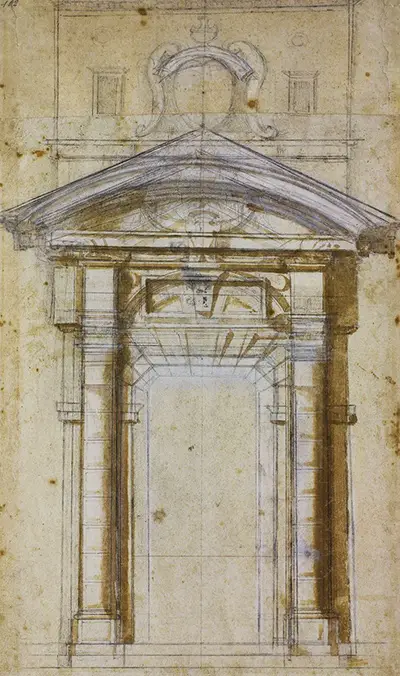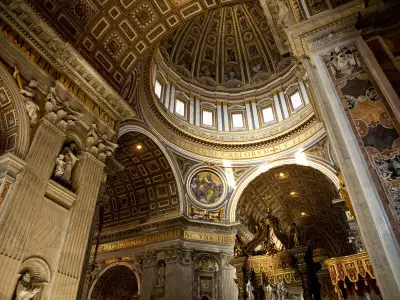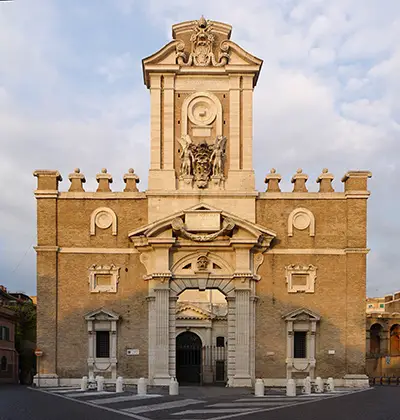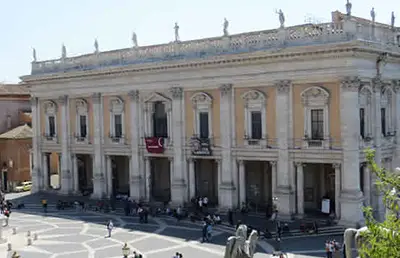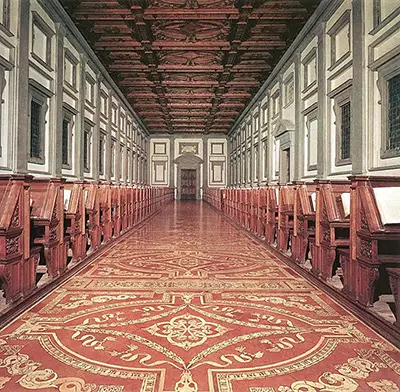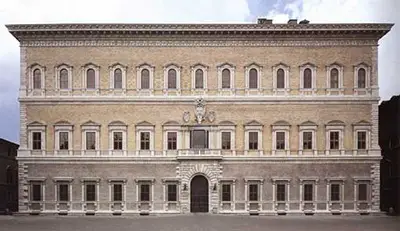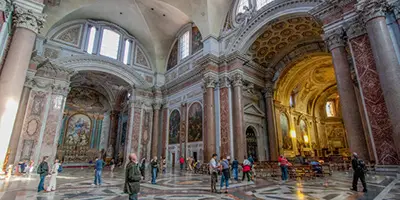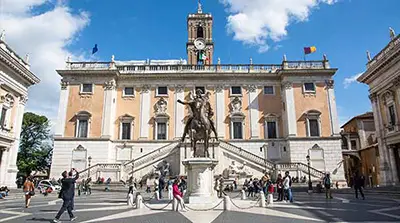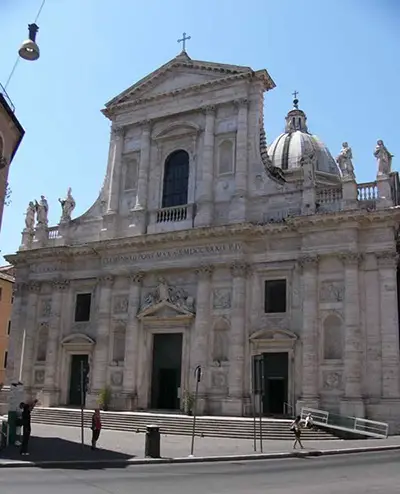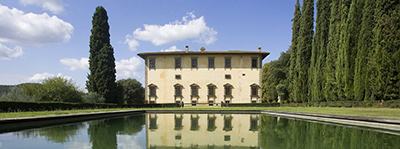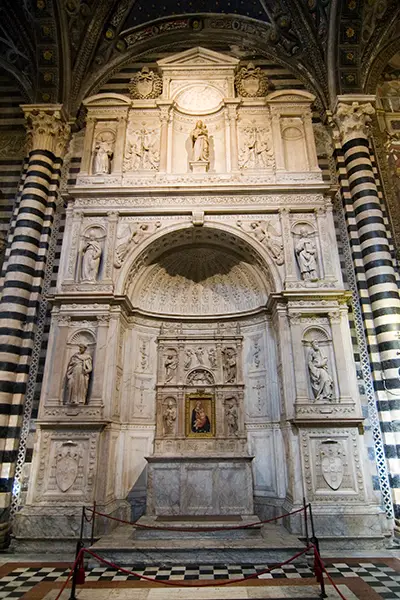The artist worked on several impressive architectural plans across Italy during his lifetime. Some of these projects were implemented soon after, whilst others never got beyond the planning stages. The stage of architectural drawing required an artist to be experienced in his craft and as such most of these commissions came towards the end of the Michelangelo's career. It was then that his reputation and technical knowledge would be at it's highest.
Michelangelo was someone who wanted to stamp his own personal touch on each and every project in which he was involved, and his architectural sketches and plans were no different in this regard. On certain projects Michelangelo would take existing designs from other architects and add his own ideas to push them up in terms of originality and technical quality.
One of Michelangelo's key architectural projects was St Peter's Basilica, for which the artist made some key contributions alongside other famous names of that time. Michelangelo had not followed the standard path into architecture design, and this allowed him to work with less restraints than other classically trained designers. His Laurentian Library, for example, incorporated a mixture of mannerist architecture, not commonly seen at that time.
Additionally, his work on The Capitoline Square would seek to play with the principles of perspective, an idea stimulated by Michelangelo's experience with other mediums. All of the significant architectural projects that Michelangelo completed involved levels of frustration for various reasons, be it considerable interference from external parties, or a diversion during construction away from elements of his own original designs.
Primarily a sculptor as well as a skilled painter, Michelangelo in addition took on the rigours and challenges of architecture. This started in 1514 when he was asked to design the facade of the Basilica San Lorenzo in Florence, but he continued to work professionally on architectural projects until his death in 1564.
Michelangelo's output was both outstanding and prolific, defying the mores of the day and ultimately challenging others (including Bernini and Borromini) to move away from the Renaissance and Mannerism towards Baroque.
The Artist's Route into Architecture
Michelangelo had absolutely no architectural training, in essence teaching himself how to design buildings and structures in a crash course of the architectural norms of the period. To this end he used the 'Codex Coner'- a compendium of decorative and architectural drawings- making sketches of classical features and motifs. Being Michelangelo though, he then rejected a lot of the traditional process for design and instead created his own.
In an effort to protect his posthumous image and to hide the massive amount of preparation that went into producing his work, just before his death Michelangelo destroyed many of his sketches and letters. As a result the full picture of how he worked to produce designs and structures that challenged the classical perfection of the Renaissance is hard to fully appreciate. Fortunately enough sketches survive to give us a reasonable idea.
The Architectural Technique of Michelangelo
The result was a very unusual method, based around his ideas of artistic composition. He believed that an understanding of the human body was necessary for successful architectural design and approached the planning of a structure much as if he were preparing a new sculpture.
Ultimately Michelangelo adapted the processes he already used as a sculptor and artist and fitted them to his meet needs as an architect.
As a sculptor his work has a multi-dimensional aspect, meaning that it can be viewed from any angle, there is no wrong vantage point from which to study it. This he replicated in his planning of architectural work.
Whereas architects of the day produced a first 'idea' sketch and then developed this in more detailed sketches on separate sheets of paper, Michelangelo produced a first sketch and then layered again and again on top of this (on the same sheet of paper) his detailed sketches.
Partly because this style worked for him, but also partly because paper was expensive and he was not inclined to waste money on it, he used this process throughout his career.
Interestingly in creating these different layers he gave his architectural designs the multi-dimensional aspect for which his sculpture is famed. As a result he was able to combine different layers to produce hybrid plans where he saw that the details in different layers worked together.
This layering of his plans gave him a different overview of what he was aiming to achieve. In turn this made it easier for him to develop and refine his ideas and thus produce something grander, more striking and more precise than simply producing design after design would.
The next stage in his process was to build either a wax or clay model, continuing to develop and refine this too until it matched his vision.
Challenging Renaissance Thinking
Italian Renaissance architecture differs from much of the rest of the Europe in that it cannot be seen as a reaction to Gothic- simply because Gothic didn't happen in Italy.
Instead Italian architecture at this time followed classical shapes and forms, taking inspiration from the great ancient Roman architecture which the city states across Italy were all surrounded by. As such Renaissance architecture was very structured with particular attention paid to symmetry, harmony, proportion and geometry.
Whilst classicism reflected the debates within society at the time of order, reason and essentially humanism, Renaissance work was seen as the harmonising of this debate with the religious principles of Christianity, producing designs that mixed the crisp simplicity of classicism with the order and harmony of creation. Renaissance architecture used columns, and often adhered to the 'central plan' layout to emphasise the symmetry and order of structures.
Given that Michelangelo as both an artist and a sculptor refused to go with the flow and follow the fashions of the day it will be little surprise that his architectural work broke the mould too. He is credited with marking a turning point in architectural design at the time, by taking what was there and simply making it his own.
His artist's interest in light, shadow and space gave him a different perspective to his contemporaries. It allowed him to see his designs not just in terms of their bigger picture, but also in terms of how they would be as living spaces. His work broke down the divisions between structure and decorative detail, allowing architects greater freedom in their approach to design.
At times he lowered ceilings in order to bring more light into rooms, at others he changed the proportions of details in order to excite a response from his audience. The Laurentian Library in Florence shows this- full of details that jar with the Renaissance classicism yet work together to produce something that (like all great works of art) arouse an emotional reaction.
Architectural Legacy
Whilst not considering himself an architect, Michelangelo achieved a mastery of the art which many of his contemporaries longed for. He is revered still for his austere brilliance and even today the buildings that he laboured over - the Medici Chapel, the Laurentian Library and St Peter's Basilica to name but a few- are regarded masterpieces.
From before his death he inspired the work of his contemporaries. Initially his work was channelled and emulated by the Mannerists, and then was taken up by the followers of Baroque a generation later. His designs and developments have been reproduced many times- the iconic dome of St Peter's Basilica has been copied again and again, through civic buildings and structures through to the Sant'Andrea della Valle in Rome and St Paul's Cathedral in London. See also the Gaudi architecture from the Catalan region of Spain.
Whilst Michelangelo may have considered himself simply a sculptor, he broadened and redefined what sculpture is, taking the role of an architect and using it to meet his purposes rather than vice versa. He made his architecture a form of sculpture, allowing others to learn from his example.
